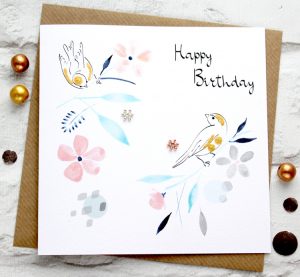I often get asked of what is needed to start a greeting card business and in fact whether it is a serious business at all. It is a shame that often people assume that greeting card business is simply a hobby and hardly earns any cash. I think it all depends on what is your product and how you run your business.
It is true that many new greeting card businesses (in fact many start ups) begin on the kitchen table. The sheer abundance of craft materials in the hobby market alongside the fantastic quality of digital print available nowadays makes a greeting card a very easy product to make and bring to market. This, alongside the fact that retailers like cards as a relatively low risk product (because consumers often buy a gift accompanied by a card) makes the greeting card market an extremely saturated and fiercely competitive market. The card designs are trend-driven and usually the life-cycle for a card is 6 to 12 months, unless you hit the right button then your bestselling design may sell for years.
So, if you are serious about turning your card hobby into business then this is another matter. To decide what type of card business is right for you, you would have to consider your skills, experience, the amount of capital you have and your personal preference.
Generally, card publishers publish two types of cards, printed cards and handmade cards. All card designs based on stamping, assembling, individually hand-painting etc. will be very difficult to product in large quantities for the trade and are considered suitable for personal use or hobby.
Printed cards are produced in large numbers and command lower trade and retail prices. They face fierce competition from cheaper printed cards in the Far East and tend to sell better in card shops than gift shops. Printed cards could be artists reproductions, collages or handmade designs and then photographed shots, photos of landscapes, flower arrangements, toys displays etc. They could also be commissions you have done for a private client who has let you use their work or elements of it for commercial use.
You could print the cards digitally to start with and once you have proven record of sales you can go and do litho printing (the difference between these two printing techniques will be highlighted in another blog post). I often hear stories of publishers just starting out doing large litho printing runs only to discover that they may never shift the cards. Tip: if you are starting out, make sure you have proven track record of selling your cards to the trade, not to your closest friends and family. It is very tempting to do litho print, where the cost per card costs a fraction of the cost for digitally printed card. However, the litho print runs tend to be in the thousands (usually a minimum of 1000 per design) and as such a litho print run is more expensive than a digital print run. Remember if you fail to sell those cards it is only a false economy and at the end of the day the cards may cost you more than having been printed digitally. You need to have large enough database of stockists who re-order regularly to make this venture viable. It would be good if your printer lets you experiment with different boards as the design can look quite different on different boards, which will also set your card aside and above the cheaper ones flooding the market in discount cards shops.

Handmade cards are more special than printed cards as they offer a different shopping experience – something done by hand will always be more special and valued than something mass produced. They also tell the recipient that somebody had carefully chosen a special card for them. Hand-finished cards face the same concerns about printed cards but they have the added embellishments like jewels, bows, dried flowers, embroidery bits and any other trinket you could think of. Handmade cards are more trend driven than printed cards and often the add-ons can be the decisive factor of their uniqueness. When you make handmade cards, make sure you make them in batches or enlist the help of family and friends when making or outsource the embellishment process if you could afford it. It is tempting to buy cheap embellishments as they are widely available from craft shops. However, as the handmade cards command higher retail price (£3 to £6 per card depending on the size) and consumers nowadays are very savvy make sure you choose good quality embellishments. The board you choose is also very important and often textured, pearlescent or lightly tinted boards are used for hand-crafted cards as they not only are better quality, they often give a more luxurious feel to the cards.

There is a common misunderstanding of what is a handmade card. I have heard publishers claim their cards are handmade just because they assemble and pack them by hand or they have drawn them by hand. I would have to say that handmade card will qualify as a handmade when components to the design are added by hand. Any other packaging process does not make them handmade. They are simply hand-wrapped, hand-packed etc. as are many other products in business. The drawn designs would then have to be called hand-drawn, hand-illustrated, hand-painted etc.
So, here we are. If you are thinking about a card publishing venture choose what are you going to do wisely and remember you could always switch and fine tune when you go along. The importance is to start.
Best of luck!












